Are you ready to learn how to start a travel blog? Great! After 15 years of being a professional blogger, and helping over a thousand people start their own travel blogs, I’m here to help.
Believe it or not, learning how to start a travel blog is easy and it’s not expensive. After following this guide, you will have a professionally designed blog up and running in minutes.
Start a Travel Blog in Minutes Following These Steps:
- Step 1: Set Up Your Domain & Hosting
- Step 2: Create Your Bluehost Account
- Step 3: Choose a Free Theme
- Step 4: Install WordPress
- Step 5: Get Your Free Course
- Step 6: Download 5 Essential Plugins
- Step 7: Design Your Logo
- Step 8: Design Your Blog
- Step 9: Write Your First Blog Post
- Step 10: Grow Your Blog
- FAQs About Starting a Travel Blog
Our WordPress Beginner Travel Blogger Course ($199 Free)
I have personally started over a dozen blogs in different niches and have helped over a thousand people start their own travel blogs. I know that it can feel overwhelming at first, but it doesn’t have to.
That’s why I’ve created my WordPress Beginner Travel Blogger Course, which will teach you how to quickly design, write and grow a successful travel blog in 5, easy-to-follow video lessons.
The course comes with access to our VIP WordPress Beginner Travel Blogger Facebook group where you’ll receive free, 24/7 blogger support from me personally, as well as the other 500+ members of the group.
The best part? The course is free when you start a travel blog through the links in this post. We get a commission when our readers start a blog using the same company we run this blog on, so we thought, why not just give away the course for free?
So we did.
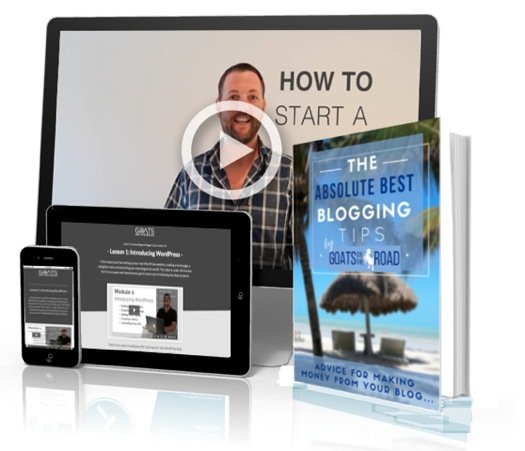
Disclaimer: All of the links to Bluehost are affiliate links, which means we receive a commission for any purchases you make using our links. It is these links that allow us to offer you our full beginner blogger course for free. Enjoy!
What You Need To Get Started
Before you start following along with our easy “How To Start a Travel Blog” tutorial, you’ll need a few things:
- A decent wifi connection (it doesn’t have to be fast wifi)
- A computer or tablet (not a smartphone)
- A credit card or a Paypal Account
- 10-20 minutes to spare
- A love for travel!
Ready to go? Let’s get started!
Prefer to watch a video instead? Click Here to skip down on the page and watch my How To Start a Travel Blog Video.
STEP 1: Set Up Your Domain & Hosting
To start your own travel blog, you’ll need 2 things.
- A Domain Name
- Hosting
Domain Name: Every blog needs to have a domain name. Like we own “www.GOATSONTHEROAD.com”. In order to own those fantastic words between the “www” and the “.com”, you have to set up a domain. Think of it as your house. You buy it and you can do what you want with it. Don’t worry, this will be free.
Hosting: This is where your blog will live online. Think of it as the land that your house sits on in the virtual world. Without hosting, you never own the land and therefore will always be limited as to what you can do with your blog. Hosting will cost $2.95 per month ($35.40/year) and it is your only expense today.
For the cheapest and most reliable hosting, we recommend Bluehost. After 15 years of blogging, we’ve gone through our fair share of hosts from free blogs and shared sites (not recomended) to GoDaddy, SiteGround and everything in between. We finally landed on Bluehost and we’ve been super happy with them.
Bluehost is one of the most popular hosts online. They’re the host we use on this blog you’re reading, and nearly a dozen other blogs and websites that we own.
The below button will open a new tab in your browser bringing you to Bluehost where you’ll get a special Goats On The Road discount (everyone loves a discount right?).
From there you can choose your domain, sign up with Bluehost, install WordPress, and get access to our WordPress Beginner Travel Blogger Course for free. I’ll explain the process below. Simply return back to this page to follow along with the steps.
Click the above button and receive a discount with Bluehost + gain access to our WordPress Beginner Travel Blogger Course.
After you click the blue button above, you’ll see the special discount screen at Bluehost. Now just click the green “get started now” button on that page.
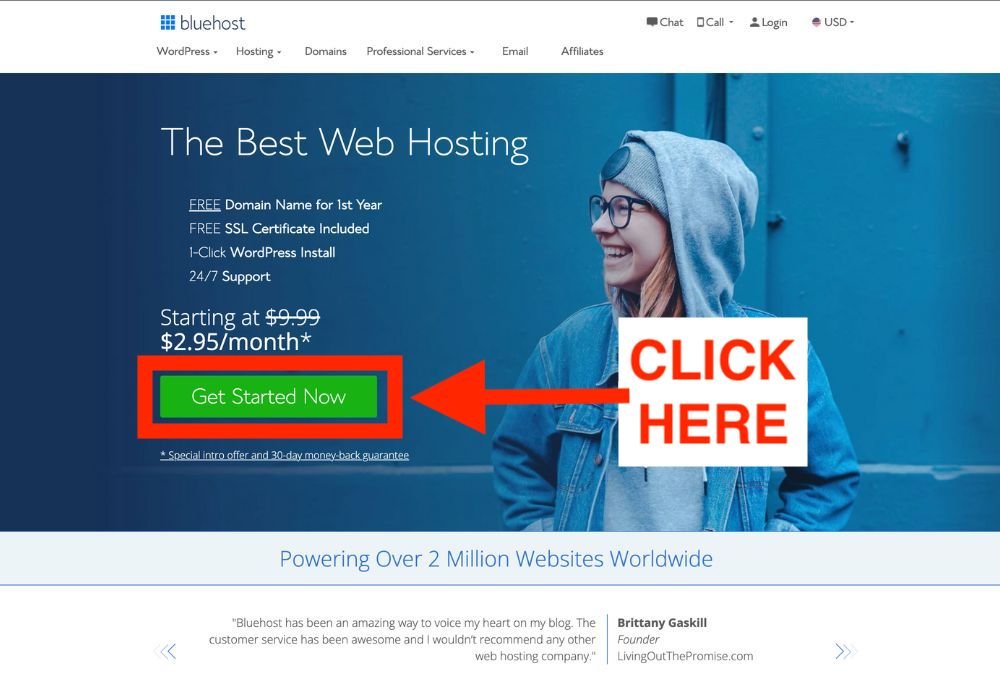
After you click the “Get Started Now” button, you’ll be brought to a new page where you will sign up for hosting.
Now you can simply choose the cheapest, most basic plan on the left and click “select”. There’s no need to spend any more than the absolute minimum today.
We’ll keep the sign-up process as cheap as possible now, you can always upgrade later.
Go back to the Bluehost tab in your browser and select the basic plan.
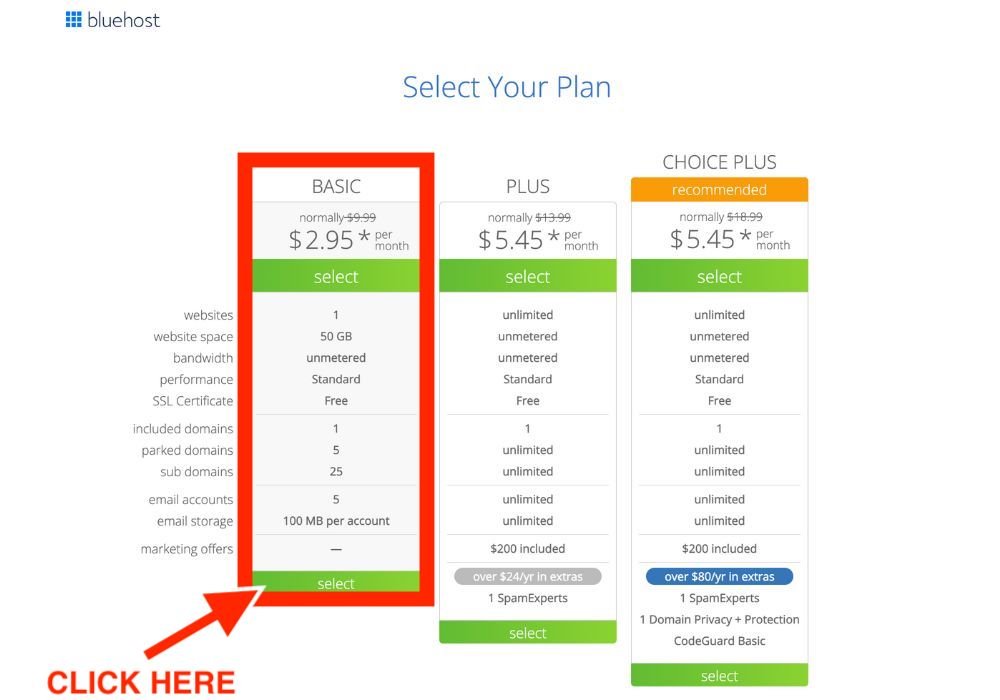
Choose Your Domain Name
Now it’s time to choose your domain. Don’t worry, you won’t be charged extra for this as it comes free with your Bluehost basic package (unlike other hosts like SiteGround that charge extra).
A lot of people have been emailing me because it’s so hard to think of a name. Trust me, I know. We’ve been there many times, and it took us a while to think of a name for our blog. Luckily, you don’t have to think of one right now.
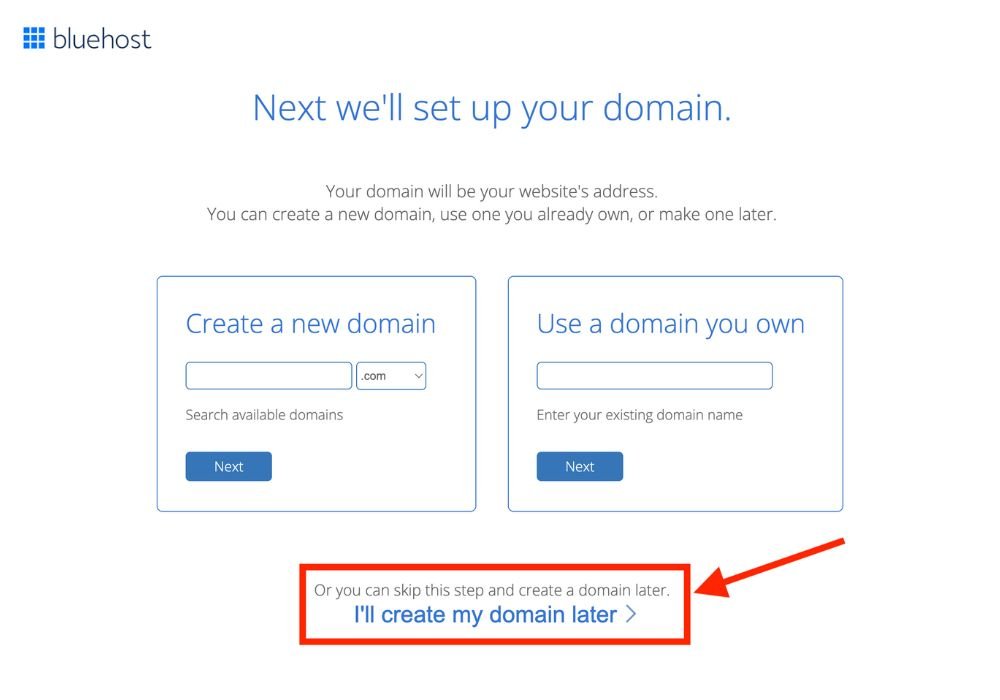
If you can’t think of a domain name now, just click the link “I’ll Choose My Domain Name Later” (pictured above). You will get a temporary domain name (example: www.abc.def.mybluehost.me) which you can change to any name later… for free.
Quick Tips For Picking a Travel Blog Name
- Don’t use numbers or hyphens. “2travelers.com” might sound cool, but it’s hard to remember and you don’t want to always have to explain “2… like the number 2” when telling people your blog.
- Keep it short. As an example: GoatsOnTheRoad is 14 characters. Try to keep your blog under 20 characters to make it easy for people to remember.
- Avoid Blog Name Limitations. Don’t call your blog “Travelling in My Twenties” because once your twenties are over, your blog name is out of date and isn’t easily changed. Similarly, don’t limit your blog with a blog name like “Budget” or “Luxury” if you’re not certain you’ll always travel that way.
- Be Memorable. Your blog is a representation of you. Try to be original. Quirky even. A name that people can remember can go a long way.
If you know what you want your domain name to be, simply type in your new domain in the left box and choose “.com” from the drop-down menu (.com websites are the best). Then click “next”.
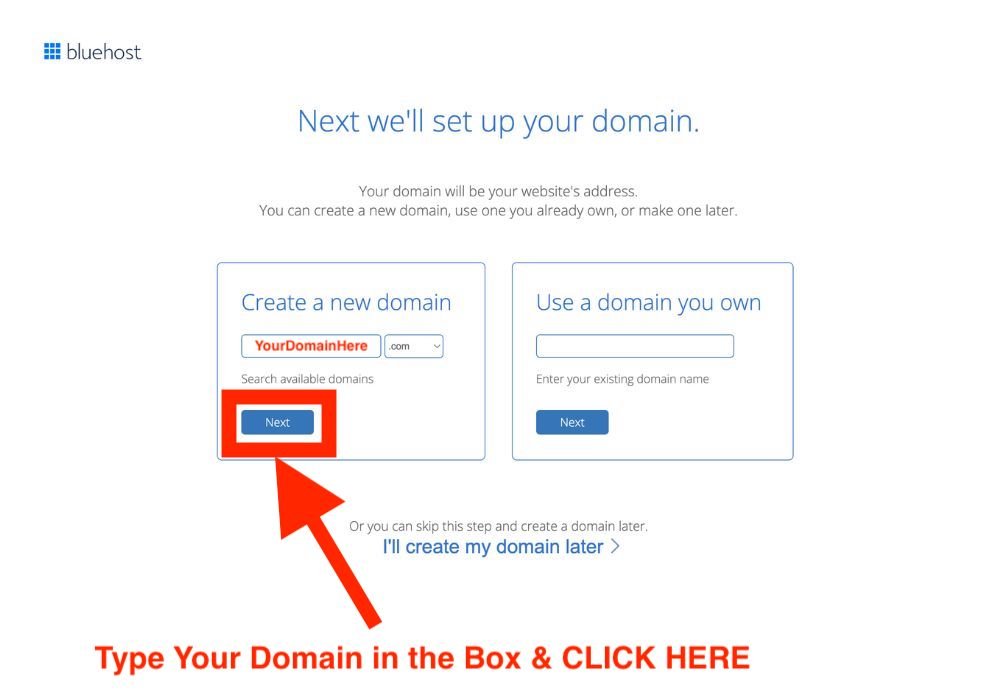
If the domain name you chose is available, the next screen you see will have a big green box at the top telling you that the name is available (pictured below). If the green box doesn’t appear, the domain is taken and you’ll have to think of another one.
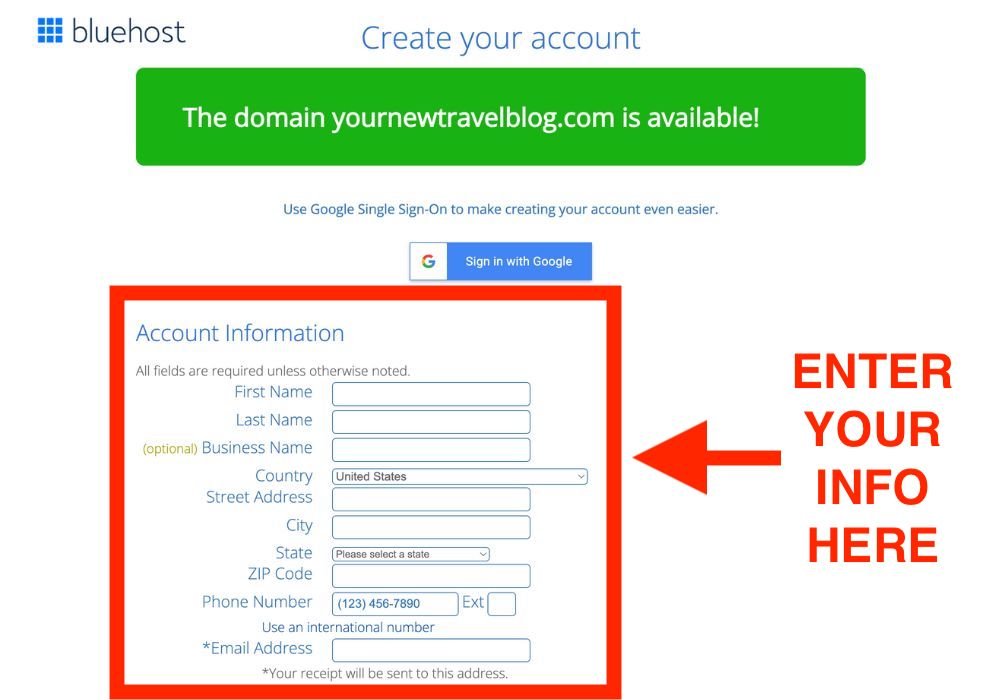
Time To Pay…
Next, you’ll have to fill out all of your new account information. It’s quick and easy.
You’ll have to make sure the address and phone number match the country (ie: if you put “France” as the country, then you should also put a France phone number and France address).
If you don’t have a phone number, just add a friend’s local phone number that matches the country you chose. You can change this at any time.
Now scroll down on the page to see the “Package Information” & “Package Extras”. Make sure the cheapest package is chosen (Basic 12 Month Price $2.95/mo).
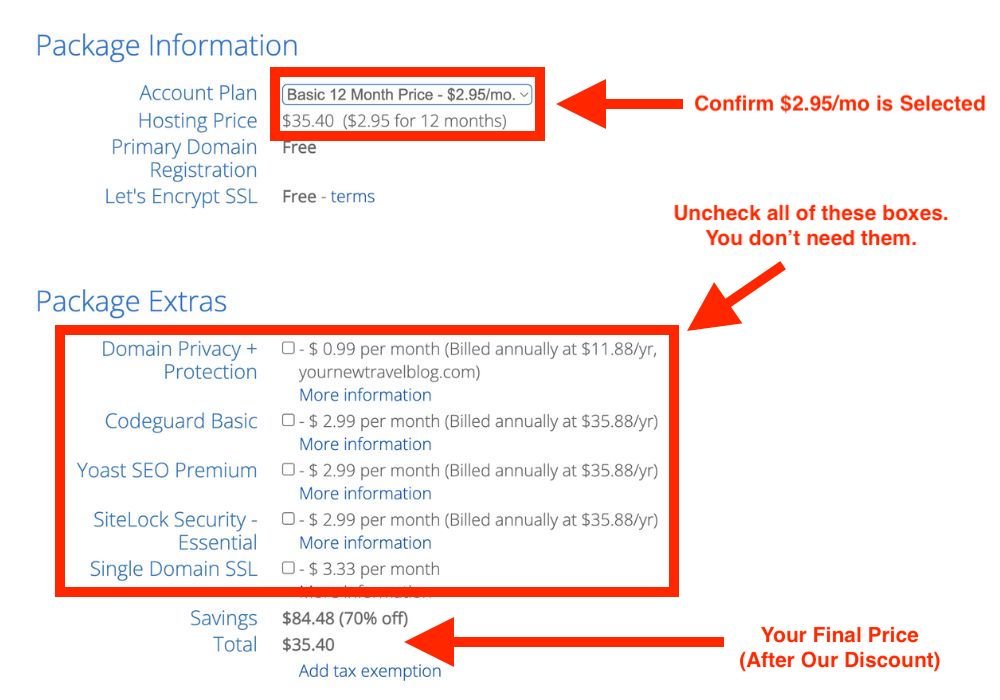
As I said, I want to teach you how to start a travel blog for the least amount of money possible today, so uncheck all the “Package Extras”. You don’t need them today and you can always add them later if you want.
Now scroll down and enter your billing information in the boxes provided. You can pay by credit card, or click “More payment options” to pay by PayPal.
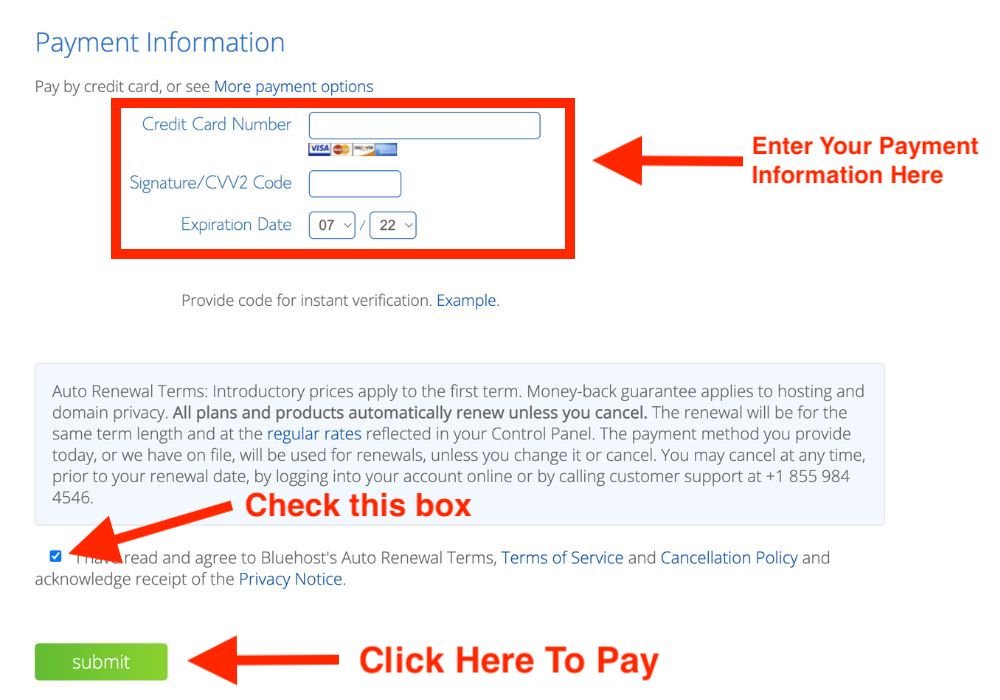
Note: Taxes depend entirely on what country you’re reading this “how start a travel blog guide” from. If you see taxes added to the total amount, it’s the local government tax and can’t be avoided. Some countries don’t charge tax on hosting and some do, but it’s not usually more than $25 or so.
STEP 2: Create Your Bluehost Account
Success! Once you pay for your hosting and see the Congratulations Page at Bluehost.
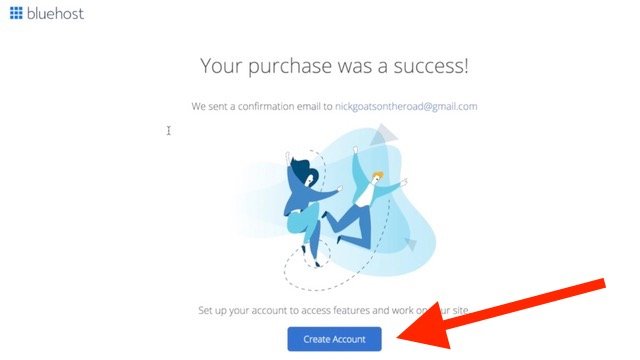
Click the “Create Account” button. Now you’ll see the welcome to Bluehost page. Try to include a capital letter, a number and a symbol if possible and make sure you write it down. This will be the password that you use to sign into your Bluehost account.
Enter in a password in the middle box and then retype it in the bottom box and hit “Create Account”.
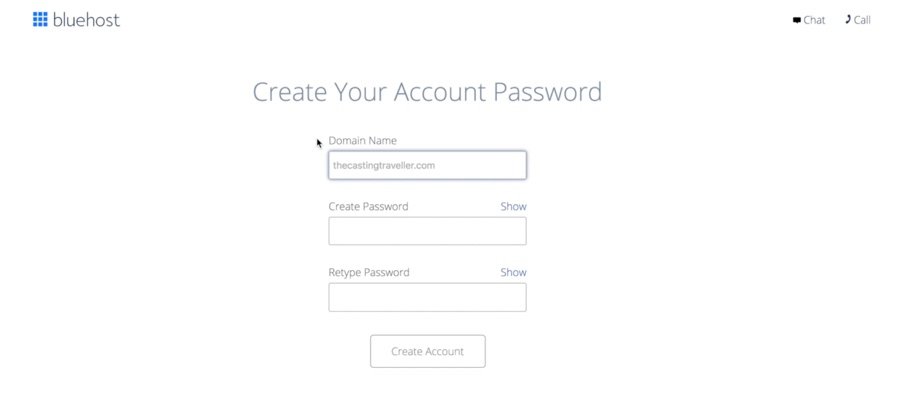
You’ll then see a screen like the one pictured below. Simply click the button that says “go to login” to continue installing WordPress.

You will now reach the page where you can sign in to your Bluehost account. To get to this page in the future, whenever you want to sign into your account, the URL is https://my.bluehost.com/cgi-bin/cplogin. You can bookmark that so that you always know how to easily log in to your WordPress Blog.
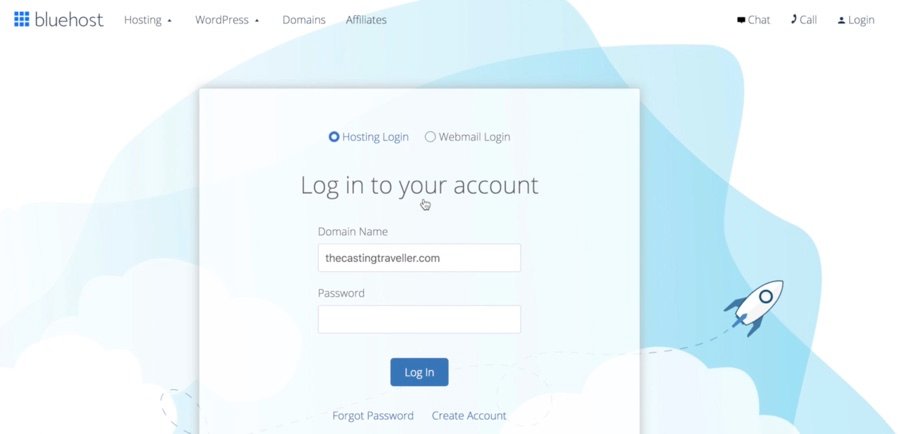
For now, login using your domain name and password that you created. The domain name should already be written in the box and your password is the one you just created. Go ahead and type that in now and login to Bluehost.
Once you have logged into Bluehost, the automatic set-up and install of WordPress will begin. That’s right… WordPress is automagically installed when you sign up for Bluehost.
What is Bluehost & WordPress?
If you’re confused and wondering why you have a Bluehost account AND a WordPress account, let me explain.
Bluehost
Bluehost is your hosting account. You won’t really need to access your hosting account all that often, but it’s where your website actually lives. You don’t have to be a geek like me and get to know your Bluehost cPanel.
After you set up WordPress, you won’t have to come back here.
WordPress
WordPress is the software you will use to edit posts and design your blog, so after this initial set-up you’ll be logging into WordPress, not Bluehost.
Let’s continue…
The next screen you’ll see is pictured below. Here you can add the name of your site (the same as your domain name), a tagline (a brief 1 sentence explanation of your blog), and where you’ll display your posts. For now, choose a different page. Don’t worry about getting everything exactly right here. I’ll show you how to change these settings in the Beginner Blogger Course.
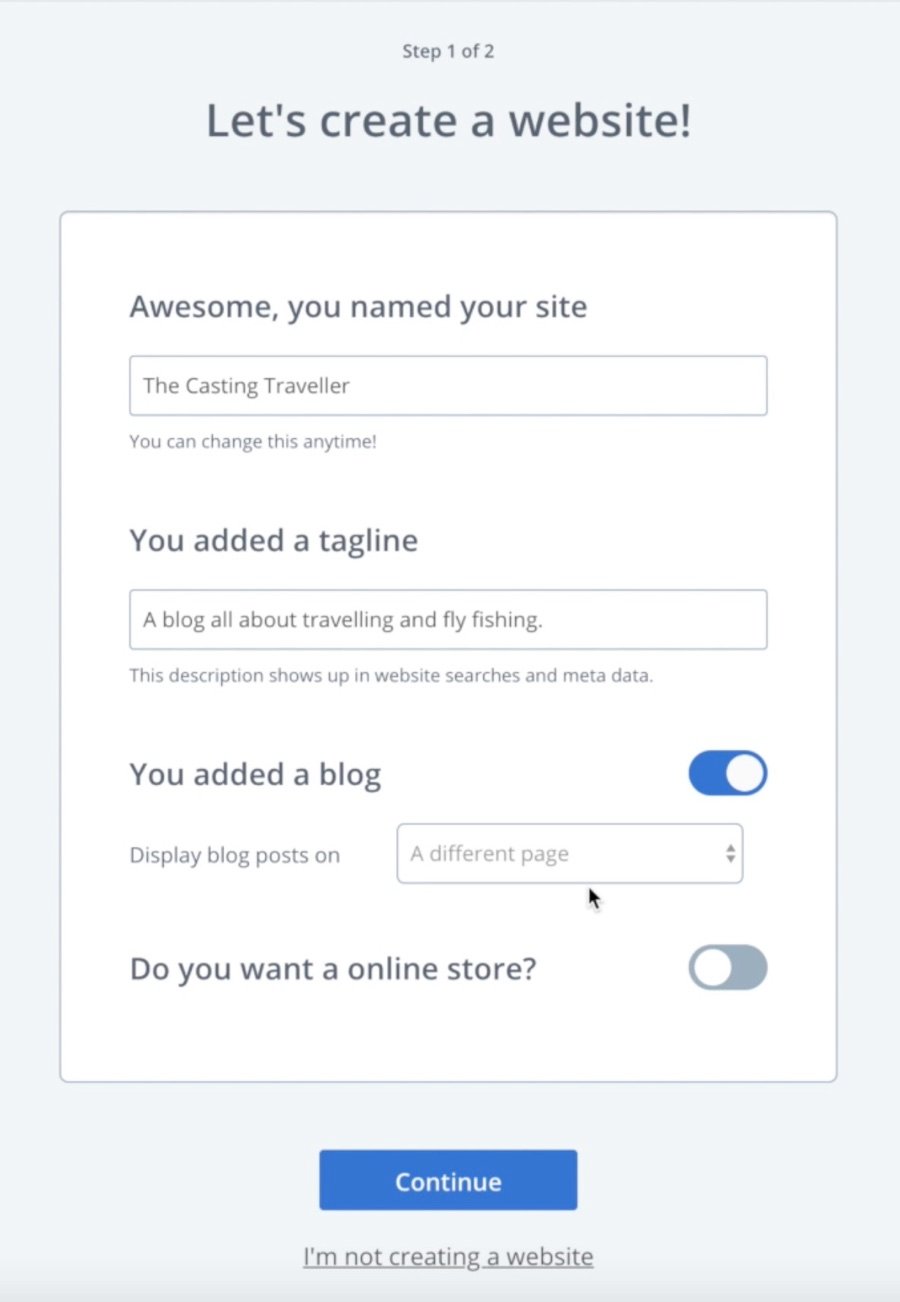
When you’re done, click “Continue”.
The next screen will be asking you about your goals. These settings really don’t matter so please don’t worry too much about them.
Simply choose “Share my ideas, photos, stories or videos.” and then click the option “a little” under “Are you comfortable with creating websites?”. Then click “Continue to Theme Selection”.
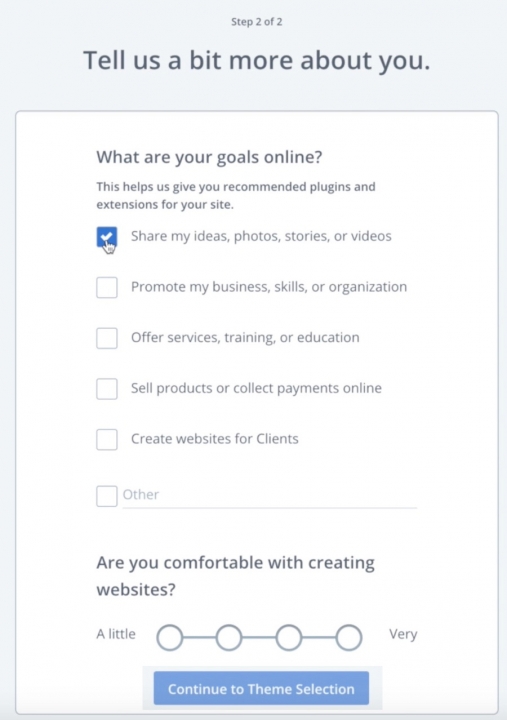
Step 3: Choose A Free Theme
Next, you’ll see a screen like the one pictured below. This screen will allow you to choose a theme for your new WordPress blog. A theme is basically a design template that you can start with so that your blog automatically has a nice-looking look and feel right off the bat.
Every blog has to have a theme. I recommend that you chose Astra from the list of themes and install it to your new blog.
I’ve started numerous blogs over the years, including new blogs this year, and I’ve always used the Astra Theme. It is by far the most intuitive, easiest to use, and fastest-loading blog theme available… and it’s free.
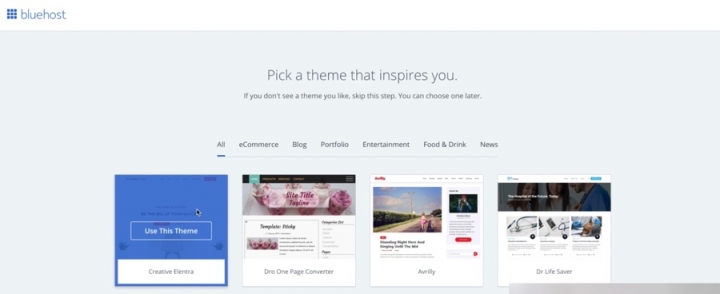
Step 4: Install WordPress
Next, Bluehost will automatically install WordPress for you. This is one of the many reasons that I love Bluehost. Many other hosts require that you install WordPress yourself. This can be confusing and time-consuming. Bluehost will do all of this for you right now.
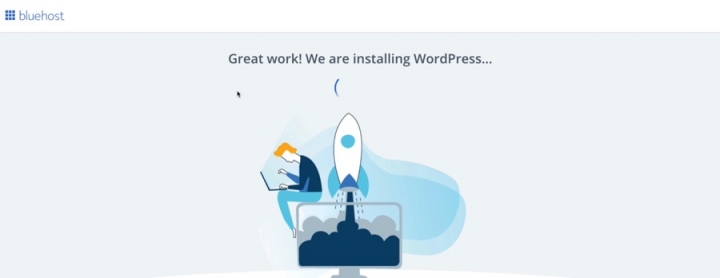
After WordPress is installed, you’ll be brought to your Bluehost Dashboard.
Great job! Your blog is up and running! Simply click the button that says “WordPress” to quickly log in. Don’t worry about the other stuff on this page, we’ll cover that in the course.
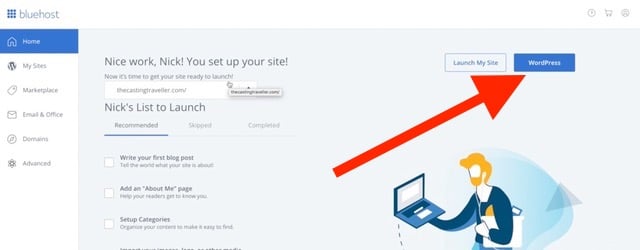
The next screen you’ll see will be the WordPress Dashboard. This screen is no longer Bluehost, you are now fully in WordPress. This is where you’ll add new posts, photos, videos and design your blog. Congratulations! You officially have your own WordPress blog now!
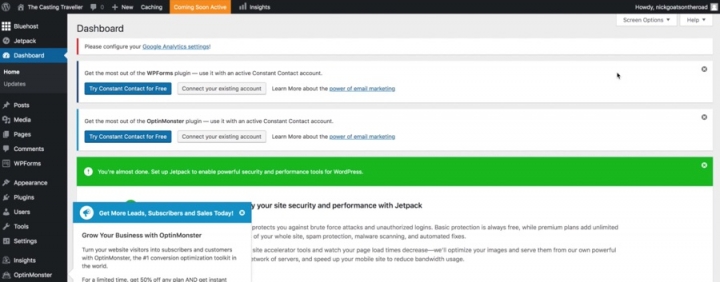
STEP 5: Get Your Free Course!
Now for the fun part. Enter your information below to download the free course.
Note: The WordPress Beginner Travel Blogger Course is only free for those who start a blog using links in this post. We will check every blog so please only enter the info after you’ve completed steps 1-4.
STEP 6: Download My 7 Essential Free Plugins
Plugins are basic add-ons to your WordPress blog that can enhance its security, site speed, and overall functionality.
I’m going to save you a lot of time by listing the 7 essential plugins that every new travel blog should have. After that, I’ll show you how to download and install them in seconds.
Askimet: If you allow comments on your blog, you’ll get spammy ones. This is the internet after all  . The Askimet plugin will automatically filter out spammy fake comments so you don’t clog your posts, slow down your site or worst of all, introduce your unsuspecting readers to comment con artists.
. The Askimet plugin will automatically filter out spammy fake comments so you don’t clog your posts, slow down your site or worst of all, introduce your unsuspecting readers to comment con artists.
Yoast SEO: We’ve written a lot about SEO on this blog and we even have a free SEO Training Course. Basically SEO means “Search Engine Optimization” which is things you can do to your blog to make sure you show up in Google more often, which in turn, means more traffic for your site, more readers and more income.
WordFence: This is a WordPress security plugin that will help thwart would-be hackers and other bad people online from trying to do bad things to your website.
Really Simple SSL: SSL is that little lock symbol ( ) you see next to the domain name of websites at the top of your browser. Simply put, this helps to keep your website secure and also helps your SEO. Every blog needs it. This plugin quickly installs an SSL so you get that sought-after lock symbol in minutes.
) you see next to the domain name of websites at the top of your browser. Simply put, this helps to keep your website secure and also helps your SEO. Every blog needs it. This plugin quickly installs an SSL so you get that sought-after lock symbol in minutes.
GA Google Analytics: This plugin is an easy-to-use plugin that will allow you to hook your site up to Google Analytics. This is how bloggers track how many people visit their site. I’ll show you how to set this up completely in the WordPress Beginner Travel Blogger Course.
Starter Templates — Elementor, WordPress & Beaver Builder Templates: This plugin has a long name, but basically it allows you to take the Astra Theme that you downloaded in Step 5 and turn it into a professional-looking blog in seconds. These templates are pre-built, beautifully designed website templates that you can add to your blog in one click.
W3 Total Cache: A caching plugin will help your website to load faster so that your readers don’t have to wait 10 minutes to see your wonderful new blog! We’ve tested nearly a dozen different free caching plugins and in our opinion, W3 Total Cache is the most effective and easiest to use. I recommend downloading this one last as it will make it more difficult to edit parts of your website. If you ever have difficulty editing your website after W3 is installed, that’s because the plugin is doing its job. To see your edits properly, hit “Clear Cache” at the top of the screen and reload the page.
How To Install Plugins To Your New Travel Blog
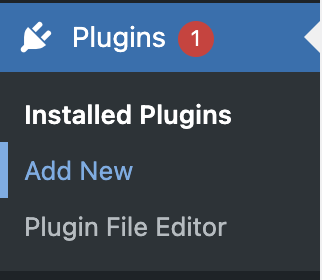 In your WordPress Dashboard (pictured below), hover over “Plugins” on the left side of the screen and click “Add New”.
In your WordPress Dashboard (pictured below), hover over “Plugins” on the left side of the screen and click “Add New”.
Now type in the name of each of the above plugins where it says “Search plugins…” and download each one. Once installed, click “Activate” and they will be working on your site. It’s that simple
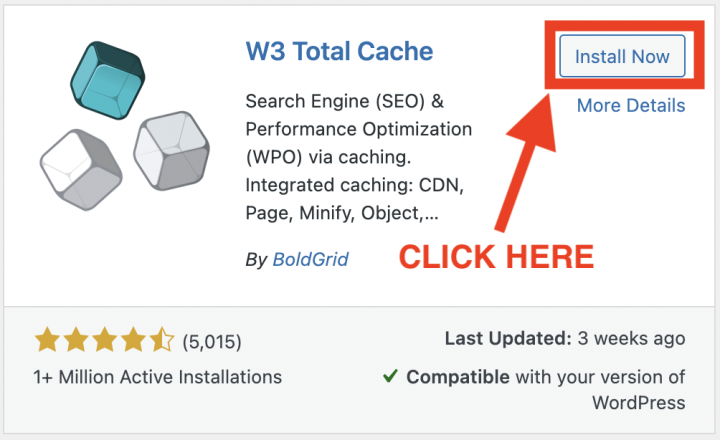
Step 7: Design Your Logo
Again, we’re going to do this for free. Head to Canva and create a free account. Then click “Create a Design” and choose “Logo”. From here you can choose from thousands of pre-built designs or you can create your own from scratch, for free.
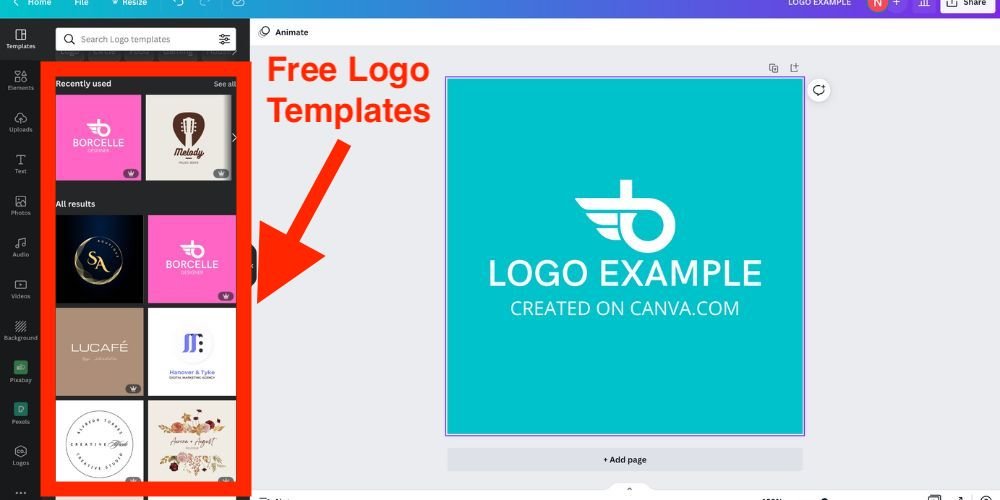
Note: The free version of Canva doesn’t allow you to download your logo with a transparent background, which is essential for most themes on WordPress. If you don’t want to pay for Canva Premium, download the design with a white background as a PNG file and then Google “png background remover” and choose a free service to make the background transparent.
STEP 8: Design Your Blog
Thanks to the Free Astra Theme that you downloaded onto your site in step 5, this part is actually really easy because you already downloaded the “Starter Templates” plugin in step 6.
Once installed, hover over “Appearance” on the left side of your screen and click “Starter Templates”.
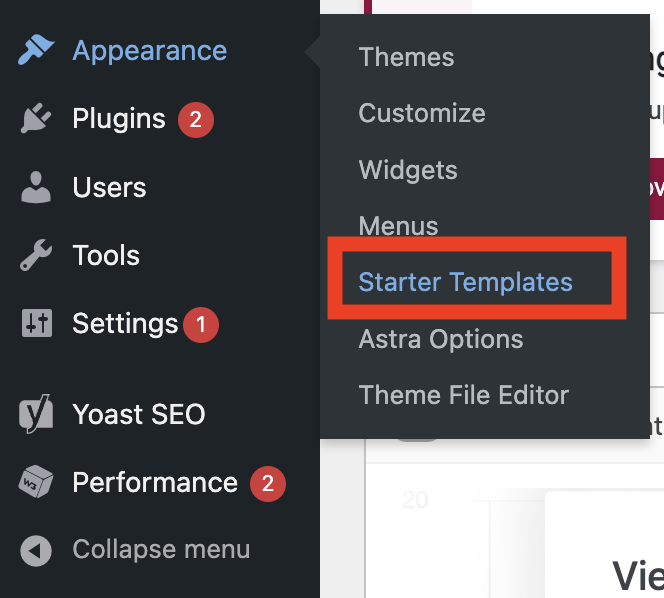
This will bring you to a screen where you can choose from dozens of free blog designs that have been professionally curated by some of the world’s leading website designers.
Just choose from the templates that don’t say “Premium” and they will be 100% free to install on your own website.
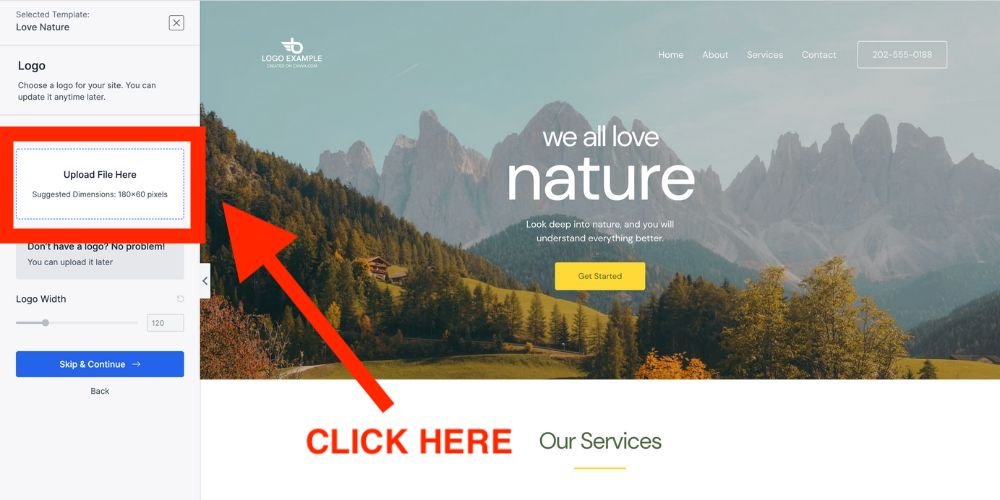
Simply click on the free template you like the most and a popup will appear to add your logo. Click “Upload Logo Here” choose the logo that you created in Step 7 and click “Continue”.
Alternatively, you can skip this step and create your logo later by clicking “Skip & Continue”.
Once you click “Continue” or “Skip & Continue” from this screen, your new WordPress Template will be added to the blog.
Back in the WordPress Dashboard, hover over the name at the top left of the screen and click “Visit Site”. Remember, if the changes don’t appear yet, make sure to clear your cache as we explained in Step 6.
Pro Tip: After choosing your design template, don’t work anymore on your design. How a website looks is not that important. The content you put on the blog and how helpful it is to your readers is the most important. These templates have been created by professional website designers who know what website viewers want. The more you change the design, the more you’ll likely take away from its simplicity and professionalism, and the more time you’re wasting not writing content.
STEP 9: Write Your First Blog Post
Now that you’ve learned how to start a travel blog and you’ve chosen your theme. You have a lot of work and research ahead of you.
For now, let’s just start with the basics. Writing a blog post. To do this, head back to your WordPress Dashboard and at the top of the screen hover over the “+New” button and click “Post”.

You’ll then be brought to the Edit Post Screen. Here you can type away and create as many blog posts as you want. Get writing! The more content you create, the quicker your blog will grow. If you can write a post a day, or even just 3 posts/week, you’re doing a great job.
The below diagram explains a little bit about the WordPress Edit Post Screen. It looks confusing but don’t worry, we explain it more in the course!
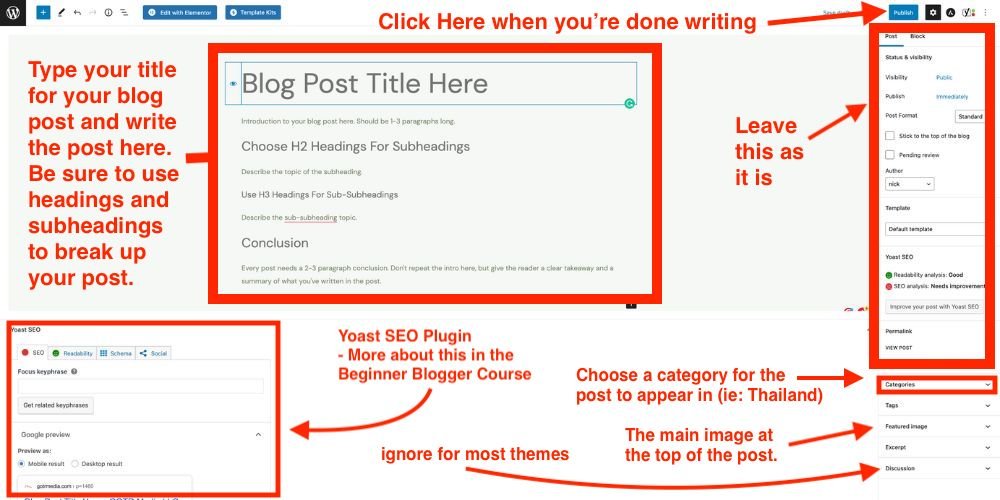
Set a schedule for yourself and stick to it. If you can only write 1 article per week, always write just 1 and publish it at the same time of day. If you can publish every Monday, Wednesday, and Friday at 4:00 pm, stick to that schedule.
Google loves it when a blog produces content on a reliable schedule… like a newspaper. Keep in mind that Google is your new boss so make sure you keep him / her happy! There’s no point in going through all of this work learning how to start a travel blog, if you’re not going to spend time writing useful content and making the Google Gods happy
Try to write things that people will find useful. How-to’s, guides, hacks etc. Like this How To Start a Travel Blog post that you’re reading now! Isn’t it useful?
Don’t just write a diary. These types of blogs hardly ever attract readers or make any money without some level of useful information. Feel free to write in a personal way, and talk about things you have done. It’s important to keep YOU inside your blog. But try to mix your travel anecdotes with useful information that your readers can use.
Now you’ll want to set up your social media accounts for your blog. This isn’t technically part of learning how to start a travel blog, but social media is extremely important for building a brand and a relationship with your readers.
Don’t use your personal social media accounts for this. Set up an entirely new Facebook fan page, Twitter account, Instagram, YouTube, Google+, Pinterest etc. Set up as many as you think you can handle and continuously post on each account.

After you’ve produced a lot of useful content (posts) on your blog and you’ve started your social media accounts, you’ll want to start with basic marketing of your blog so that you can grow your readership and eventually earn money.
To do this, you’ll want to share your articles on your social media accounts, and do A TON of guest posts. You may have even found this How To Start a Travel Blog Guide in your Facebook news feed this morning. That’s because we always share our best articles to social media, and you should too!
Another great way to market your blog is through guest posting (writing articles for other blogs / websites and linking them back to your blog).
Email all of your favourite bloggers and ask them if you can write an article on their site and link back to your new blog from it. If your blog is about budget travel, then the anchor text should be “budget travel”… like this: Budget Travel. In that link, the words “Budget Travel” link to GoatsOnTheRoad.com.
Those words are called “anchor text” and the more links you have with certain anchor texts, the more likely Google will show you in search results for those terms. Again, if you’ve spent all this time learning how to start a travel blog, you should also learn how to write great SEO articles so that your blog appears in Google results.
Be careful not to create hundreds of the exact same anchor texts in different guest posts because it can start to look spammy. Choose variations of your main anchor texts and link to specific articles with anchor texts that match the articles’ main point.
For example, if I wanted to write multiple guest posts and link back to this post I would use anchor texts like How To Start a Travel Blog, Start A Blog, Create a Blog, Start a Blog From Scratch etc.
Now you’re going to continue to write new content, add new pictures and posts to your social media accounts and write a ton of guest posts for months on end. This will be your routine. Recycle it over and over and watch your traffic grow.
It will be VERY slow for the first year, but suddenly things will speed up, Google will start to recognize you and you’ll start growing a loyal readership. Once you’ve grown some traffic, you’ll be able to start earning an income.
Note: To keep track of your traffic, you’ll want to set up Google Analytics. Click Here to learn how to do that.

Because there is so much information in our eBook, I won’t get into too much detail about creating posts and using WordPress in this How To Start a Travel Blog post. Running social media and marketing your blog online is very important, but for now, we’ve covered the basics to start a blog that can one day earn you a full-time income.
Step 10: Grow Your Blog
That’s it! You’re done! You’ve started a travel blog. Now comes the fun part. You need to make it successful.
Don’t worry. We’re here to help. Check your inbox for the WordPress Beginner Blogger Course and follow along with the videos in the course to learn exactly how we grew our 5 different blogs to be successful.
Didn’t Apply For The Course Yet?
If you started your blog but haven’t received your course yet, check your junk mail. If it’s not there, enter your info below and click “Download Now”.
Note: The WordPress Beginner Travel Blogger Course is only free for those who started a blog using this how to start a travel blog guide. If you didn’t start a blog through Goats On The Road, you can purchase the course here.
How To Start a Travel Blog FAQs
How much does it cost to start a travel blog?
The minimum cost to start a travel blog today is $2.95 per month (or the equivalent in your local currency). You will have to pay for this annually so the total cost today will be $35.40+tax.
Why do I have to pay for a blog if WordPress is free?
This part is confusing for a lot of people and understandably so. Why would you pay for a blog if WordPress is FREE? In reality, WordPress is free, but only for a very lite version of it. If you want to design your blog, customize it and be able to upgrade elements of it, you’ll need to pay for hosting to unlock the full version of WordPress.
Also, on the free WordPress you will never own your domain or your blog and someone could easily steal it from you. By signing up for Bluehost, you’ll get a free domain registration (ie: YourBlogName.com), you’ll own all rights to your new blog, and you’ll be able to customize it exactly how you want and you’ll be able to monetize it, and earn money one day.
Luckily when you sign up for Bluehost using the link in this post, the full version of WordPress is free. You also get a free domain name, free advertising credit, our free course, our free ebook and free 24/7 support from both Bluehost chat and from our amazing Facebook Group. That’s a lot of FREE.
What’s the difference between a Blog and a Website?
There is no difference between a blog and a website. A blog is a website, and many websites have a “Blog” section. A blog is simply part of a website where you create blog posts. Any website can (and should) have a blog section.
There are too many blogs online today. Can I still “make it” as a travel blogger?
We hear this ALL THE TIME from would-be bloggers. Sure, when we started Goats On The Road in 2012, there were fewer travel bloggers online. But even then, people told us the market was too saturated.
Back then, there was no opportunity for bloggers. Today, virtually EVERY travel company knows the value of advertising on travel blogs. That’s why more travel bloggers today are earning 6-figures per year than ever before.
I’m not currently traveling, what can I blog about?
Just as many people want to read about saving for travel and planning for a big trip as they do about the trips and destinations themselves.
Write about quitting your job. Write about building your blog. Write about saving money and planning out your big itinerary. This is what all travel blogs are based on and it will likely be your most popular content down the road.
I can’t think of a travel blog name. What should I do?
This is the easiest excuse to squash because if you start a blog using this how to start a travel blog guide, you won’t have to think of a name today. Bluehost allows you to buy your domain without a name, install WordPress, begin blogging and then pick your name later.
This is perfect because it will give you the opportunity to create some content and really get a feel for where your blog is going and what your niche will be. That way, you can pick a name that suits your blog, after your blog is created. Genius.
I don’t know enough about blogging, the internet, or website design. Can I still start a travel blog?
First of all, most bloggers who you read today started out just as new as you (or even newer). When we started Goats On The Road, we didn’t even know what WordPress was, we had barely used Facebook and had never taken a web design class in our lives.
The FREE eBook and course that you’ll receive after starting your blog today include the basics of designing your blog, as well as how to add photos, posts, and plugins. They also give you a beginner’s rundown of WordPress.
What if I don’t have enough money to start a blog?
I’m sorry but I have to be brutally honest here. If you have enough money to pay for the device that you’re reading this post on, then you have enough to pay for your blog, which will cost you less than a cup of coffee ($2.95) per month. You might have to save up but think of those few dollars as an investment. Invest something today and if you keep at it, you could be earning a full-time income from blogging one day.
How do I run a travel blog if I don’t travel internationally?
As far as running a blog goes, this is actually an advantage for you. The hardest thing about building a successful blog is nailing down a niche. If you’re only travelling within your country or within your region, you’ll already have a great niche.
You can become the expert on your home province, state, or country in no time! You’ll be able to work with local businesses far easier than an international blogger works with international brands.
What if I’m not a very good writer or photographer?
As long as you can write fluently in your language, you’re a good enough writer to be a blogger. People who read blogs online don’t want to read poetic language and jargon. People online want to get straight to the point! Think about it. When you search the web for answers, you generally want the quick and easy version.
If you read the posts on this blog, you’ll notice that we never over-describe things or try to sound like a magazine or novel. Blogging is simple writing.
When we started this blog, we were horrible photographers. Luckily there are a lot of free tutorials for photography on YouTube and it’s quite easy to learn how to take great photos and with just a few hours of practice, you can improve your photo quality dramatically, even if you’re just using your smartphone.
How long will it take for my blog to become successful and earn an income?
This depends entirely on you. The last blog I created was earning around $8,000 per month after one year, but that’s not a normal progression.
I hired writers for that website so I was churning out 7 posts per week for 6 months straight.
If you work 20-30 hours per week on your blog spending time on important things like writing blog posts and marketing, then you could be earning a full-time income within a year or two.
I don’t have a passion for travel, writing, or photography. Should I still learn how to start a travel blog?
If that is the case, then this job isn’t for you and you should consider following a path towards success by doing something that you’re truly passionate about. If you don’t love the job of blogging, then it will feel like just that… a job.
Travel blogging should be so fun that even when if spend 4-8 hours per day at your laptop, you’re happy because you love building up your own travel business. There will be hard days even if you’re passionate, but if you’re not passionate at all about travel, then you’ll never make it as a travel blogger.
How To Start a Travel Blog Tutorial Video
Some of us (like me) are visual learners. If you’d prefer to follow along with a video instead of reading this long post, you can click to watch my YouTube video below that explains exactly how to start a travel blog.
GREAT WORK! You’re now a blogger!
You can check out our Travel Blogging Section for more about running a blog, plus, you will learn A LOT from the course, which should be arriving in your inbox soon. It covers everything from how to earn free travel, get flown around the world on press trips, and get paid to travel.
If you bought your domain and built your blog through affiliate links in this How To Start a Travel Blog post, thank you so much for your support. Please check your inbox for the free beginner blogger ebook and look out for our email training that will be sent out to you over the coming weeks!
If you have any questions about running a blog, I’ll be there to help you in the WordPress Beginner Travel Blogger Course Facebook Group.
Disclaimer: All of the links to Bluehost are affiliate links, which means we receive a commission for any purchases you make using our links. It doesn’t cost you anything extra, in fact you can save as much as 63%, and it helps to keep this blog running so we do appreciate your support.
Congratulations. You are now officially a blogger!
Like This Article? Pin it!
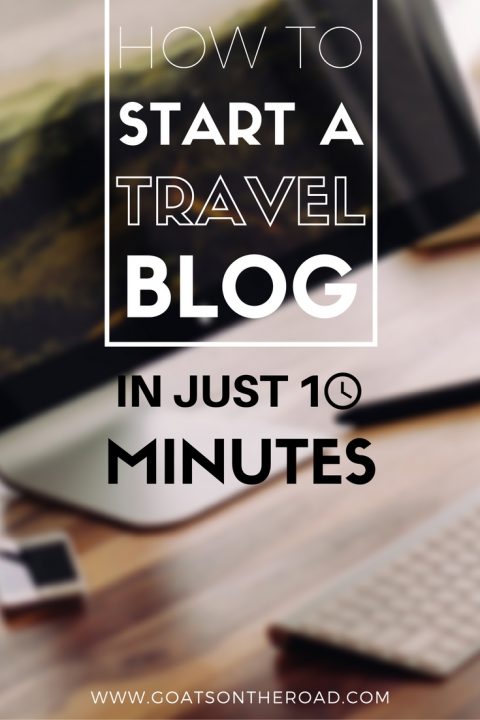
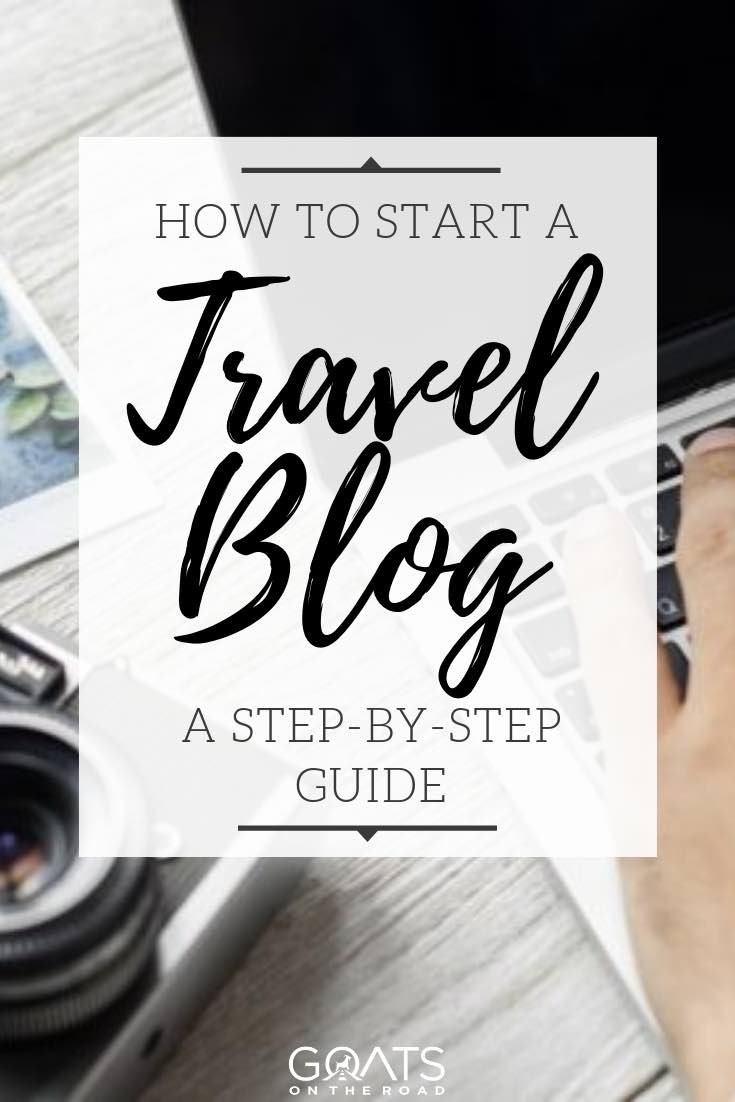

The post How To Start a Travel Blog in 2022 (Complete Step-By-Step Guide) appeared first on Goats On The Road.




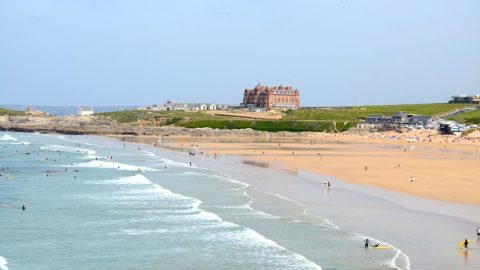
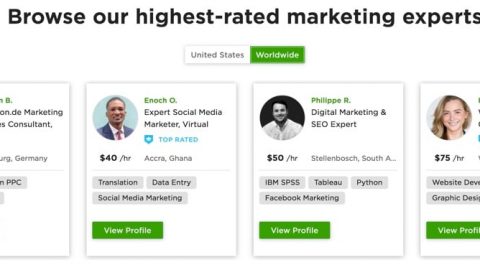
Recent Comments